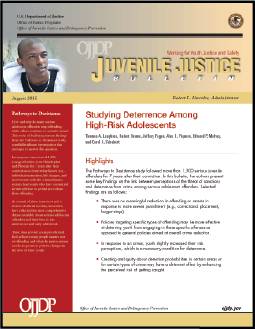
The impact of sanctions, whether threatened or applied, on deterrence of crime by high-risk adolescents is examined. Sections of this bulletin include: background; key terms; increasing deterrence through severity—institutional placement and length of stay; increasing deterrence through certainty—offenders' perceptions of risk; increasing certainty though arrest; behavioral responses to changes in risk perceptions—the certainty effect; the deterrent effect of ambiguity in offender risk perceptions; policy implications; and conclusion. Some of the results are: There was no meaningful reduction in offending or arrests in response to more severe punishment (e.g., correctional placement, longer stays); Policies targeting specific types of offending may be more effective at deterring youth from engaging in these specific offenses as opposed to general policies aimed at overall crime reduction; In response to an arrest, youth slightly increased their risk perceptions, which is a necessary condition for deterrence; Creating ambiguity about detection probabilities in certain areas or for certain types of crime may have a deterrent effect by enhancing the perceived risk of getting caught" (p. 1).
